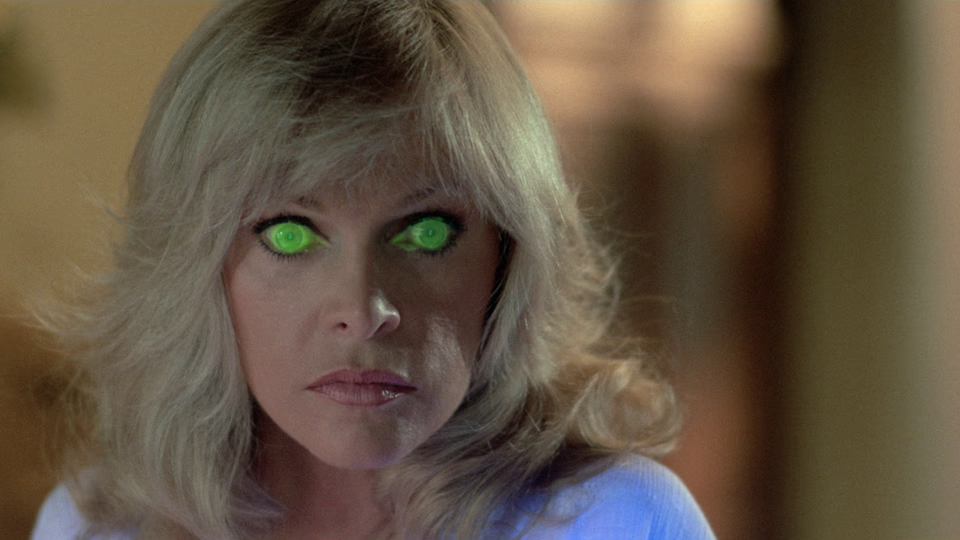Mausoleum

Mausoleum follows Susan, a woman possessed by a demon who embarks on a killing spree until her psychologist intervenes.
The opening sequence, set twenty years in the past, surprises with its formal rigor. We see a young Susan at her mother’s funeral with her aunt. After the service, a distraught Susan flees across the cemetery. She sees the Nomed family’s mausoleum tomb engulfed in an unnatural flame and awash in rain despite the clear skies. She enters, and inside discovers a tomb. Here, the film’s use of light and sound evokes Dario Argento’s Suspiria or Inferno. Indeed, I wondered if the film wasn’t positing an unofficial Mother of Tears entry set in Los Angeles.
But no. Instead, Susan’s psychologist, Dr. Andrew, provides voiceover explaining Susan is from the cursed Nomed family line, and should any firstborn female enter the mausoleum, they will release a demon who will possess them.
Fast forward twenty years to present day. Susan has settled into married life. She and her husband Oliver head over for a night of dancing. At the nightclub, a drunken oaf gropes Susan on the dance floor, then gets belligerent when she refuses his advances. As Susan and Oliver are leaving, the same drunken man stumbles by them and enters his car. Susan’s eyes glow green and the car bursts into flames, killing the man. The green-eye effect underwhelms, as the film keeps cutting back to a freeze-frame shot of Susan.
Susan and Oliver return home, but their live-in housekeeper, played by LaWanda Page, senses something’s amiss and tries to warn Oliver the next morning. When he dismisses her concerns, she threatens to quit. Oliver convinces her to stay until he returns from a business trip, then heads out the door. Frustrated, Page marches upstairs to check on Susan, muttering, “There’s some strange shit goin’ on in this house.”
LaPage then walks in on Susan, who’s glowing green, mid-transformation. Cue some comical strings on the soundtrack and over-cranked footage of LaPage running out of the house, trying to catch Oliver.
She fails, returns to the house and pours herself a “drink of the good stuff,” J&B, of course. With a shaking hand, she raises the glass to her lips, saying, “I ain’t been this nervous since I’ve been black.”
She creeps back upstairs and sees Susan further changed. More comedic music and over-cranked footage as LaPage flees out the front door, bags packed, running down the street.
This sequence elicited a big laugh and proved the film’s highlight.
With Page and Oliver gone, the film settles into a pattern of Susan transforming into the demon and murdering various people in her Los Angeles home. First, the gardener, whom she seduces first. Then her aunt and a hapless delivery man. She also takes an excursion to the mall where she murders an art gallery employee. These kills prove gory—the mall killing proffers a copious amount of blood—and creative. In-between, the film proffers several gratuitous shots of Susan topless.
After Oliver returns home the film delivers its lone scene transcending schlock horror. Oliver awakens at night to see Susan rocking in a chair, staring out the window, her face half-transformed. The comparably subtle makeup, quiet score, and simple staging combine to create an unsettling image of a not-quite human Susan. It’s a scene out of a better movie.
Oliver exits the room and calls Dr. Andrew, who sees Susan the next day and puts her under hypnosis. While hypnotized, Susan speaks with the demon’s voice and exhibits the glowing green eyes. Shaken, the doctor calls a colleague for help, setting up the final showdown.
The performances throughout underwhelm, but the cast appears engaged and not just reciting lines. The clunky dialog doesn’t help. Consider this mouthful when Dr. Andrew is phoning his colleague Roni, saying, “My initial diagnosis was extreme schizophrenic regression. Just a second. Just wanna gather myself, Roni. It was extreme schizophrenic regression manifested by inner impulses and outer physical projection, including vocal and facial fantasies.”
The aforementioned showdown features the demon in all its rubber-suited glory. John Carl Buechler (who’d later direct Friday the 13th Part VII: The New Blood) receives a “special effects makeup creator” credit, and while the suit doesn’t look cheap, it still looks like a suit. The film’s inventive cinematography betrays the seams during a bird’s-eye shot of the demon returning to the crypt where we see the sneaker tread on the bottom of the demon’s foot.
I can forgive slips like this. I can also forgive the stiff acting and disjointed nonsensical plotting. But I can’t forgive boring.
The film lacks any sense of pacing, groping for transitions between the special effects scenes. At one point the film offers an inexplicable montage of the gardener’s day. We see him chopping a stump, spreading fertilizer, eating his lunch, driving a tractor, napping, and sharpening an axe.
When Dr. Andrew calls Roni, we get an extended, one-sided phone conversation. The camera holds on the doctor as he talks, waits for a response we can’t hear, and talks again. It’s all exposition we already know, and even worse, he repeats everything once Roni arrives.
These chunks of dead air drag down an otherwise entertaining B-Movie. The early inventive cinematography and atmospheric production raise our expectations. The practical effects may not convince, but they charm nonetheless. But schlock like this must never bore. Mausoleum takes its foot off the gas too often, stalling out when it should be peeling out. B-Movie aficionados may appreciate its transcendent moments, but others can pass.